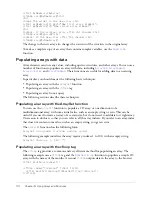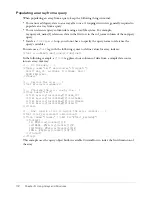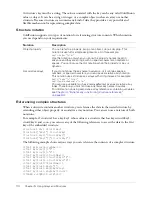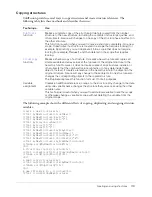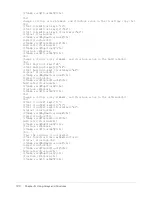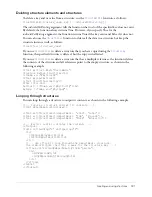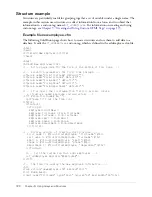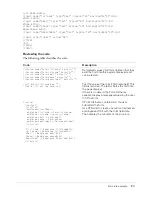
116
Chapter 5: Using Arrays and Structures
Creating and using structures
This section explains how to create and use structures in ColdFusion. The sample code in this
section uses a structure called
employee,
which is used to add new employees to a corporate
information system.
Creating structures
You can create a structure by creating a first key-pair or by using the ColdFusion
StructNew
function.
Creating structures by assigning values
You can create a structure by assigning a key-value pair. For example, the following line creates a
structure named myStruct with one element, name, that has the value Macromedia.
<cfset myStruct.name="Macromedia">
Creating structures using a function
You can create structures by assigning a variable name to the structure with the
StructNew
function as follows:
<cfset
mystructure
=StructNew()>
For example, to create a structure named departments, use the following syntax:
<cfset departments=StructNew()>
This creates an empty structure to which you can add data.
Use this technique to create structures if your application must run on ColdFusion server versions
5 and earlier.
Value of the second entry in the
key2 array<br>
#myStruct.key2[2]#<br>
#myStruct["key2"][2]#<br>
#myStruct[key2Var][2]#<br>
#myStruct[key2Var][var2]#<br>
<br>
Output the value of the second entry in the
structure’s key2 array using the following notation:
•
object.property notation
•
associative array notation with a constant
•
associative array notation with a variable
•
associative array notation with variables for both
the array and the array index
Value of the struct2key2 entry in
the key3 structure<br>
#myStruct.key3.struct2key2#<br>
#myStruct["key3"]["struct2key2"]#<br>
#myStruct[key3Var]["struct2key2"]#<br>
#myStruct.key3["struct2key2"]#<br>
#myStruct["key3"].struct2key2#<br>
<br>
</cfoutput>
Output the value of second entry in the structure’s
key3 embedded structure using the following
notation:
•
object.property notation
•
associative array notation with two constants
•
associative array notation with a variable and a
constant
•
object.property notation followed by associative
array notation
•
associative array notation followed by
object.property notation
Code
Description
Summary of Contents for ColdFusion MX
Page 1: ...Developing ColdFusion MX Applications...
Page 22: ...22 Contents...
Page 38: ......
Page 52: ...52 Chapter 2 Elements of CFML...
Page 162: ......
Page 218: ...218 Chapter 10 Writing and Calling User Defined Functions...
Page 250: ...250 Chapter 11 Building and Using ColdFusion Components...
Page 264: ...264 Chapter 12 Building Custom CFXAPI Tags...
Page 266: ......
Page 314: ...314 Chapter 14 Handling Errors...
Page 344: ...344 Chapter 15 Using Persistent Data and Locking...
Page 349: ...About user security 349...
Page 357: ...Security scenarios 357...
Page 370: ...370 Chapter 16 Securing Applications...
Page 388: ...388 Chapter 17 Developing Globalized Applications...
Page 408: ...408 Chapter 18 Debugging and Troubleshooting Applications...
Page 410: ......
Page 426: ...426 Chapter 19 Introduction to Databases and SQL...
Page 476: ...476 Chapter 22 Using Query of Queries...
Page 534: ...534 Chapter 24 Building a Search Interface...
Page 556: ...556 Chapter 25 Using Verity Search Expressions...
Page 558: ......
Page 582: ...582 Chapter 26 Retrieving and Formatting Data...
Page 668: ......
Page 734: ...734 Chapter 32 Using Web Services...
Page 760: ...760 Chapter 33 Integrating J2EE and Java Elements in CFML Applications...
Page 786: ...786 Chapter 34 Integrating COM and CORBA Objects in CFML Applications...
Page 788: ......









